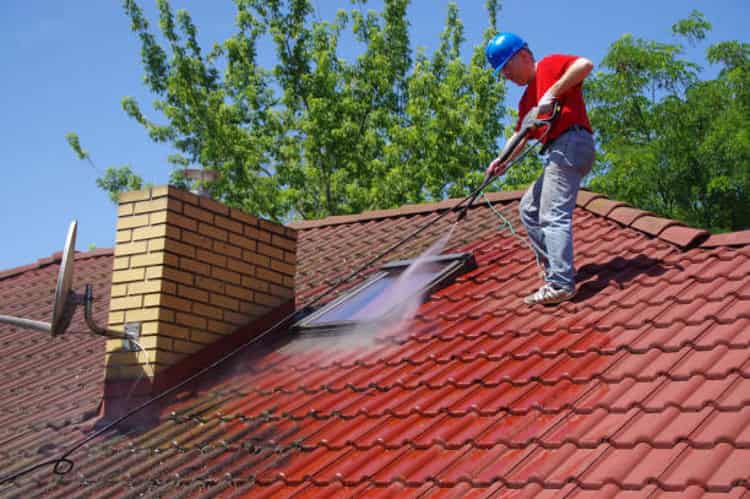Key Takeaways:
- Understanding the benefits of maintaining a clean roof.
- Assessing different methods suitable for various roofs.
- Optimal timing to conduct roof cleaning sessions.
- Pre-cleaning preparation tips for homeowners.
- Important safety guidelines for effective and safe cleaning.
- Post-cleaning maintenance to keep the roof in good condition.
- Insights on choosing between professional services and DIY approach.
The Importance of Keeping Your Roof Clean
Prudent homeowners understand that a well-maintained roof is critical to the structural integrity of a house. It’s not merely a visual enhancement but a compulsive measure to assure the health and longevity of your home. Accumulating debris and organic growth can lead to water retention and erosion of roofing materials, resulting in leaks and a greater susceptibility to weather damage. Roof cleaning reduces these risks while providing energy-saving benefits by improving sun ray reflection and keeping your home cooler during the hot months. A clean roof also increases the effectiveness of rain gutters by reducing the likelihood of blockages that can cause water to seep into the home’s foundation, far exceeding its aesthetic advantages.
Exploring Roof Cleaning Methods
Numerous methods are available for roof cleaning, each with unique applications and benefits. Homeowners can choose a gentle strategy, like soft washing, which is particularly effective for shingle roofs prone to damage from more invasive techniques. On the other hand, pressure washing is a suitable choice for more resilient roofing materials, such as metal or tiles. These services often involve eco-friendly, biodegradable chemical solutions for siding cleaning, which are also utilized to break down organisms harmful to roofing materials. Properly assessing the roof’s condition and material type is paramount before deciding on the best cleaning method, as improper application can expedite wear and tear on the roof, thus negating any temporary benefits achieved from cleaning.
The Best Season for Roof Cleaning
Selecting an appropriate time for cleaning your roof is nothing short of strategic planning. Ambitious homeowners eager to banish unsightly stains must contemplate the whims of nature before scheduling a cleaning. Climatic conditions influence the efficacy of the process—too hot, and the cleaning solution may evaporate prematurely; too cold, and it might not activate correctly. Mild, overcast days typically provide the best conditions, allowing the solution to permeate and effectively remove build-up without quick drying. Checking your regional climate history and forecasts is a sensible step to timing your roof cleaning perfectly. This preventive measure is a long-term investment in your property, preserving its appearance and functionality.
Preparing Your Home for Roof Cleaning
Commencing with a clear strategy is critical to a successful roof cleaning process. Home preparation safeguards a property’s aesthetic touches and the integrity of its landscaping. Prudent measures such as draping protective tarps over plants and vegetation, removing patio furniture or play equipment in the trajectory of falling debris, and alerting neighbors to upcoming activity can prevent disputes and damage. It’s also essential to assess the roof itself, seal any open vents, and ensure that gutters and downspouts are devoid of any obstruction to facilitate the free flow of cleaning solutions and rinsing water. This level of preparedness can convert a potentially daunting task into a seamless activity.
Safety First: Roof Cleaning Do’s and Don’ts
While essential, roof cleaning is fraught with safety concerns that must be meticulously addressed. The alliance of ladders, heights, and slippery surfaces necessitates stringent adherence to safety protocols. Robust slip-resistant footwear, safety harnesses, and eye protection are bare essentials when approaching this task. Employing a buddy system for continuous ground support is wise while also adhering to the “three points of contact” rule for ladder stability. When utilizing chemical cleaners, awareness and preparedness for potential spills or splashes are non-negotiable, prioritizing personal and environmental safety. Respecting these guidelines will secure homeowners from undue risks and potentiate a successful cleaning outcome.
Maintaining Your Roof Post-Cleaning
After the immediate gratification of a freshly cleaned roof, the subsequent challenge is to prolong this pristine state. Vigilant upkeep is the underpinning of long-term roof health, with periodic inspections as proactive measures to detect and address budding issues. Regular debris removal, such as fallen leaves and twigs, is instrumental in averting the recurrence of moisture-holding layers that welcome moss and algae. Clear gutters act as additional bonuses, bolstering the roof’s defenses against water damage and ensuring proper drainage throughout the seasons. Such diligent maintenance amplifies the benefits of your cleaning efforts and is a testament to a well-looked-after home.
Professional vs. DIY Roof Cleaning: What to Choose?
In today’s era of boundless DIY tutorials, many homeowners might be tempted to take roof cleaning into their own hands. Although this approach may initially seem cost-effective, weighing the potential risks and inefficiencies against hiring a specialized cleaning service is essential. Expert cleaners come armed with the optimum tools, understanding of effective chemicals, and the savviness borne out of experience to perform the job precisely and safely. Assessing the credentials and reputation of potential professional cleaners is key; online resources offer invaluable insights into industry standards and customer experiences. A balanced assessment of your skills, together with the risks associated with the employment, will lead you to an educated decision that best matches your position and protects the longevity of your investment.



Leave a Reply